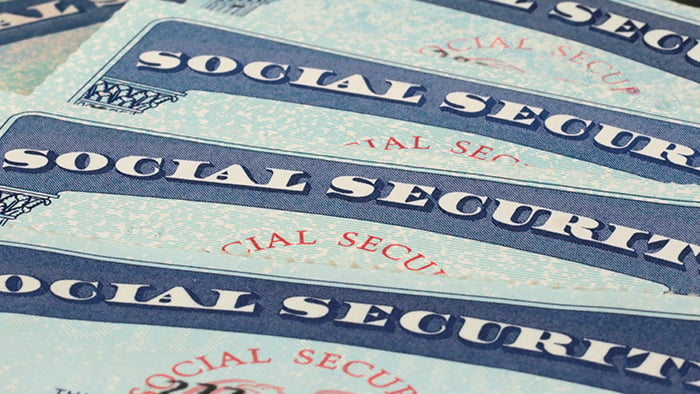How do I know if someone is using my Social Security number?
You can check whether someone is using your Social Security number by reviewing your credit reports, Social Security benefits statements, government communications, and bank statements for unusual activity. You can also use monitoring tools to scan the dark web or get alerts of data breaches involving your SSN to discover whether it’s at risk of being used fraudulently.
Social Security fraud and identity theft are significant threats, so it’s essential to be vigilant. According to the Federal Trade Commission, identity theft accounted for about 18% of all fraud reports in 2024, with over 1 million reports filed.
Check credit reports for suspicious financial activity
The first thing you should do to find out if someone’s using your Social Security number is check your credit score and report. Look for financial activity you don’t recognize, such as loan applications or new accounts being opened. If you spot anything unfamiliar, it may mean someone has your SSN and is using it to commit credit fraud.
Check for any changes to your Social Security benefits
If you receive any Social Security benefits, such as disability income or unemployment support, check for unexplained changes to the amount you’re receiving. Similarly, if you find yourself denied your existing government assistance, it may be a sign that a fraudster is abusing your Social Security number.
You can find information about your benefits claims and any changes to your entitlements in Social Security Statements delivered in the mail, or you can check your Social Security benefits online with a my Social Security account. You should also look out for any communications regarding new benefit applications that you didn’t initiate.
Check mail, phone calls, and emails carefully
If someone has stolen your Social Security number, you may start receiving unfamiliar communications like bills for services you never signed up for. If the identity thief has accumulated debt in your name, you may get phone calls, letters, or text messages from debt collectors.
 Pay attention to unexpected or unusual communications related to your SSN.
Pay attention to unexpected or unusual communications related to your SSN.
Look for government communications relating to services that you haven’t used. For example, scammers with your SSN may file a fraudulent tax return in your name to steal money owed to you. If you’re notified that your tax return has been completed before you’ve filed it yourself, contact the IRS immediately.
Identity thieves could also use your SSN to access your Medicare account and receive medical services or prescriptions in your name. Check your account regularly for unusual activity, as Medicare claims are typically visible within 24 hours of being processed.
Review your bank statements for unusual activity
Check your bank statements for any activity you don’t recognize, no matter how big or small the charge. Fraudsters with access to your bank account may start by making small transfers or purchases to avoid detection. If you notice any payments you don’t remember making, it’s possible your SSN has been compromised along with other sensitive information.
Most banking apps allow you to set up alerts or notifications for transactions, which can help you spot unauthorized payments earlier so you can take steps to protect yourself.
Scan the dark web for data breaches
If you suspect your Social Security number has been stolen, run a dark web scan to see if it appears on the dark web. Data stolen in data breaches, often including SSNs and other sensitive personal information, is sometimes sold to cybercriminals, identity thieves, and scammers on dark web marketplaces.
 Fraudsters may share or sell your SSN and other information online.
Fraudsters may share or sell your SSN and other information online.
Dark web monitoring services can alert you if your personal information is found on the dark web. Avast Secure Identity monitors the web, dark web, and social media for your personal information, such as passwords, credit card details, driver’s license, medical insurance, and more.
What to do if your Social Security number or card is lost or stolen
Report your Social Security card as lost or stolen as soon as possible after discovering that it’s missing. Then contact the relevant authorities, take steps to protect your credit, and monitor your credit report closely to help mitigate potential damage to your finances and identity.
Here’s a more detailed look at the key steps to take if you know or believe a thief has your Social Security number:
1. Report the identity theft to the FTC and the police
If you’ve suffered from identity theft, you should report it to both the Federal Trade Commission (FTC) and the police. To report identity theft to the FTC, visit IdentityTheft.gov and follow the instructions, providing as much information about the incident as possible. You’ll receive a personal recovery plan made up of recommended steps to follow based on your situation.
To file an identity theft report with the police, go to your local police station with proof of your identity and share as much information as possible about the theft. Make sure to request a copy of the police report — you’ll need this or your FTC report if you want to place an extended fraud alert to help protect your credit.
2. Place a fraud alert or security freeze on your credit report
Placing a fraud alert or credit freeze can help protect your finances and credit score by limiting access to your credit report, in effect preventing new credit applications from being made fraudulently. A fraud alert prompts creditors to verify the applicant’s identity while a credit freeze blocks credit file access altogether.
To freeze your credit, you’ll have to contact all three credit bureaus individually. To place a fraud alert on your report, you only need to contact one bureau, and they must alert the others.
 For a credit freeze, contact all three credit bureaus separately. For a fraud alert, you only need to contact one credit bureau.
For a credit freeze, contact all three credit bureaus separately. For a fraud alert, you only need to contact one credit bureau.
An initial fraud alert lasts one year, but with an official identity theft report from the FTC or police, you can request an extended fraud alert which lasts seven years. A credit freeze lasts indefinitely, protecting your credit until you decide to lift it.
Fraud alerts don’t prevent you from taking actions that require credit checks. You’ll still be able to apply for jobs, rent an apartment, and apply for insurance while the alert is in place — you may just need extra identity verification. However, you’ll need to lift a credit freeze temporarily whenever you want to grant access to your file for credit checks.
3. Contact the place where your SSN was used for identity theft
If your Social Security number has been compromised and used for fraudulent purposes, contact the organization or business where it was used for identity theft. Reporting the incident to the relevant organization can help prevent further fraudulent activity in your name.
4. Contact the Social Security Administration and the IRS
You should also report SSN theft to the Social Security Administration (SSA) online at oig.ssa.gov/report or via their fraud hotline by calling 1-800-269-0271. This may help prevent the identity thief from using your details to apply for benefits fraudulently.
Similarly, requesting an IRS Identity Protection PIN (IP PIN) from the Internal Revenue Service (IRS) can help prevent identity theft leading to tax fraud. An IP PIN is a unique six-digit number used to verify your identity when filing your taxes, helping prevent unauthorized people from filing in your name.
5. Monitor your credit reports regularly
Even after taking proactive steps to protect your credit and report the theft to relevant authorities, it’s important to monitor your credit reports and watch for signs of fraud. Check that no unauthorized accounts are opened in your name and that none of your existing accounts are modified without your permission.
You can request a free online credit report weekly via Annual Credit Report or subscribe to a credit monitoring service that offers regular credit report access.
How to protect your Social Security number
You can help protect your Social Security number by storing your Social Security card in a safe place to limit the risk of loss or theft, avoiding sharing it with anyone unless absolutely necessary, and taking steps to make your digital accounts more secure.
Here’s some more detail on how to help prevent your Social Security number from being stolen or misused:
-
Protect your digital accounts: Use a strong, unique password for each of your online accounts and consider getting a secure password manager to keep them organized.
-
Don’t share your SSN: Only share your Social Security number when necessary. The fewer people and organizations who know it, the safer it is.
-
Avoid carrying your Social Security card: Keeping your card with you at all times increases the chances it will get lost or stolen. Instead, store it securely in a safe or lockbox at home.
-
Use an identity theft protection service: Identity theft services monitor for security breaches that reveal Social Security numbers and other sensitive information. Avast Secure Identity provides powerful identity theft protection and detects potential threats to help you act more quickly when your SSN is at risk.
-
Watch out for scams: Online scams or phishing attacks may try to trick you into revealing your number or take you to an unsafe website, which can result in a stolen Social Security number.
Lock your Social Security number
You can lock your Social Security number, also sometimes known as freezing it, by going to the government’s E-Verify website. Placing a “Self Lock” on your SSN prevents employers from checking your work eligibility through E-Verify. If an identity thief tries to apply for a job using your SSN, the verification process will fail.
If you need to apply for a job, you can unlock your SSN temporarily while the employment eligibility checks are completed.
What can someone do with your Social Security number?
An identity thief with access to your Social Security number may be able to commit various types of fraud in your name, including credit fraud, benefit fraud, and tax fraud. They might also sell your SSN to other bad actors via illegitimate marketplaces.
Here’s a more detailed look at how a criminal can misuse your SSN:
-
Financial fraud: Open credit cards and loans, leaving unpaid debt and interest in your name and potentially causing long-lasting damage to your credit score.
-
Tax fraud: File tax returns in your name to claim your refunds for themselves, causing problems when you come to submit your return.
-
Medicare fraud: Access medical services or benefits using your identity, leaving you with incorrect medical records, unpaid bills, or depleted coverage.
-
Fraudulent benefit claims: Claim government benefits you’re entitled to, like unemployment, disability, and retirement payments.
-
Criminal identity theft: Use your identity in police reports following a crime so they can avoid the repercussions.
-
Sell it on the dark web: List it for sale to other criminals on the dark web, leaving you exposed to fraud.
Protecting your SSN is crucial to safeguarding your identity and financial well-being.
Use comprehensive security software to protect your identity
It's easy to leave your Social Security card at home and be more mindful of who you share your SSN with, but protecting it from the risk of data breaches is trickier, as these threats are largely out of your control. However, you can control how quickly you’re alerted to these threats, giving you more power to act quickly to protect your identity.
Subscribe to Avast Secure Identity for features that can help you continuously monitor for your sensitive personal data online and receive alerts if it’s potentially compromised. You’ll also get support from our identity restoration specialists who’ll be on hand to set things right and try to help you recoup financial losses if you fall victim to identity fraud.














